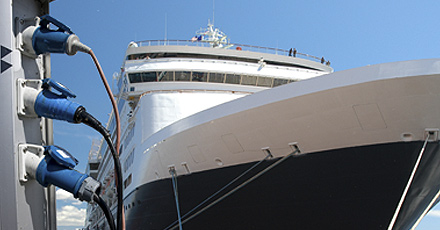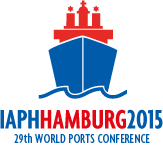
Alternative Energy Supply: Hamburg wants to plug in Cruise Ships
To bring power to the terminals - that is the aim of the alternative energy supply concept which the Senate of Hamburg approved in September. Shore power will predominantly be provided to the many cruise ships docking at the Elbe port. The aim of the project is to substantially reduce emissions from ships at berth both in the port and in the city. The planning and implementation of the pilot project is the responsibility of the Hamburg Port Authority (HPA).
Hamburg is a popular cruise ship destination. The 2013 cruise season will be the busiest on record with half a million passengers scheduled to visit the city. In the previous record month of May, 38 vessels called at the port and more than 100,000 passengers passed through Hamburg’s cruise ship terminals. All in all, Hamburg expects to welcome 177 cruise ships right in the heart of the city this year.
The metropolis on the Elbe substantially benefits from the cruise boom and expects a value creation across industry sectors of about 270 million euros. So far, over 1,500 jobs have been created in the cruise industry and related sectors. In order to cope with the rising numbers of cruise ship calls and passengers, sufficient capacities must be provided, which goes hand in hand with the responsibility to ensure that emissions from cruise ships are considerably reduced while they are berthing at the port.
The resolution adopted by the Senate includes the installation of shore power equipment at the terminal in Altona. In addition, it provides for establishing the required infrastructure at the terminal in HafenCity to enable the provision of electricity to cruise ships from private power barges. Investments of 14.4 million euros are needed to realise the concept. The European Commission has promised 3.55 million euros to fund the project, which underpins the significance of the project as a “lighthouse” for cruise shipping in Europe – after all it will be the first shore power facility on the continent.
If the technologies used prove successful, the investment in the pilot project will have been worth it. Engineers can then start working on solutions to supply other seagoing vessels with shore power. – The HPA is in charge of realising the project which, once implemented, will be a further step towards making Hamburg a smartPORT, while simultaneously allowing the HPA to pursue its sustainability strategy.
Hamburg is a popular cruise ship destination. The 2013 cruise season will be the busiest on record with half a million passengers scheduled to visit the city. In the previous record month of May, 38 vessels called at the port and more than 100,000 passengers passed through Hamburg’s cruise ship terminals. All in all, Hamburg expects to welcome 177 cruise ships right in the heart of the city this year.
The metropolis on the Elbe substantially benefits from the cruise boom and expects a value creation across industry sectors of about 270 million euros. So far, over 1,500 jobs have been created in the cruise industry and related sectors. In order to cope with the rising numbers of cruise ship calls and passengers, sufficient capacities must be provided, which goes hand in hand with the responsibility to ensure that emissions from cruise ships are considerably reduced while they are berthing at the port.
The resolution adopted by the Senate includes the installation of shore power equipment at the terminal in Altona. In addition, it provides for establishing the required infrastructure at the terminal in HafenCity to enable the provision of electricity to cruise ships from private power barges. Investments of 14.4 million euros are needed to realise the concept. The European Commission has promised 3.55 million euros to fund the project, which underpins the significance of the project as a “lighthouse” for cruise shipping in Europe – after all it will be the first shore power facility on the continent.
If the technologies used prove successful, the investment in the pilot project will have been worth it. Engineers can then start working on solutions to supply other seagoing vessels with shore power. – The HPA is in charge of realising the project which, once implemented, will be a further step towards making Hamburg a smartPORT, while simultaneously allowing the HPA to pursue its sustainability strategy.
smartNEWS



